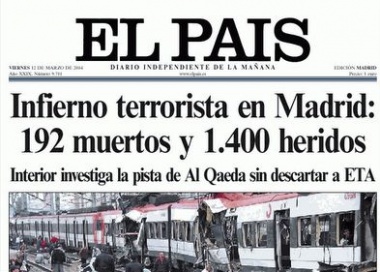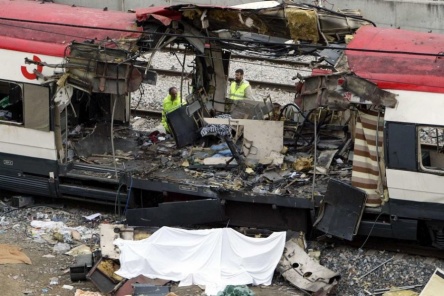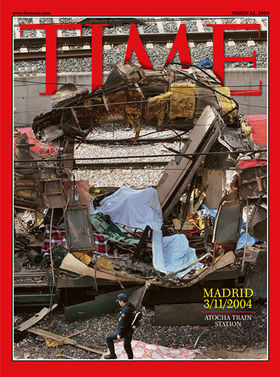Difference between revisions of "2004 Madrid train bombings"
(tidy) |
m (hcard) |
||
| (6 intermediate revisions by 4 users not shown) | |||
| Line 2: | Line 2: | ||
|location=Madrid, Spain | |location=Madrid, Spain | ||
|wikipedia=https://en.wikipedia.org/wiki/2004_Madrid_train_bombings | |wikipedia=https://en.wikipedia.org/wiki/2004_Madrid_train_bombings | ||
| − | |constitutes=bombing, terrorism | + | |constitutes=bombing, mid-level deep event?, Acts of terrorism, Operation Gladio/B? |
| + | |ON_constitutes=terrorism | ||
|ON_perpetrators=Al Qaeda | |ON_perpetrators=Al Qaeda | ||
|locations=Madrid, Spain | |locations=Madrid, Spain | ||
|fatalities=191 | |fatalities=191 | ||
|injuries=2050 | |injuries=2050 | ||
| + | |abbreviation=11-M | ||
|start=March 11, 2004 | |start=March 11, 2004 | ||
|end=March 11, 2004 | |end=March 11, 2004 | ||
|image=2004 Madrid train bombings.jpg | |image=2004 Madrid train bombings.jpg | ||
|image_width=380px | |image_width=380px | ||
| − | |description=A Spanish equivalent of [[7/7]], targetting civilians and blamed on Al Qaeda | + | |description=A Spanish equivalent of [[7/7]], targetting civilians and blamed on [[Al Qaeda]] |
| + | |type=Mass murder, time bombings, terrorism | ||
}} | }} | ||
The '''2004 Madrid train bombings''' (known in Spain as '''11-M''') were a set of 10 bombs which exploded on four trains in [[Madrid]] in the space of a few minutes. | The '''2004 Madrid train bombings''' (known in Spain as '''11-M''') were a set of 10 bombs which exploded on four trains in [[Madrid]] in the space of a few minutes. | ||
==Official narrative== | ==Official narrative== | ||
[[image:Madrid train.jpg|left|444px|thumbnail|The remains of a bombed train.]] | [[image:Madrid train.jpg|left|444px|thumbnail|The remains of a bombed train.]] | ||
| − | On March 11, 2004, around 7:40 a.m., ten bombs exploded on four trains in the space of a few minutes. This was carried out by | + | On March 11, 2004, around 7:40 a.m., ten bombs exploded on four trains in the space of a few minutes. This was carried out by "[[Muslim terrorist]]s" organised by [[Al Qaeda]]. The date appears to have been selected with reference to Spanish domestic politics, because the events took place just three days before the general elections in which the People’s Party (of the political right) of outgoing President [[José María Aznar]] was presented as the favorite.<ref name=gr2009/> |
==Corporate News Coverage== | ==Corporate News Coverage== | ||
| Line 29: | Line 32: | ||
==Investigation?== | ==Investigation?== | ||
The [[BBC]] quotes an unnamed "senior Spanish police source involved in investigating the bombings" that there was "no doubt from the very start" that [[ETA]] was not involved.<ref>http://www.bbc.com/news/world-europe-26526704</ref> | The [[BBC]] quotes an unnamed "senior Spanish police source involved in investigating the bombings" that there was "no doubt from the very start" that [[ETA]] was not involved.<ref>http://www.bbc.com/news/world-europe-26526704</ref> | ||
| + | |||
| + | ==Operation Gladio== | ||
| + | [[Jean Marie Creton]] was prosecuted for international arms trafficking by the Brussels Criminal Court. Creton was mentioned in a TV doc by [[assassinated]] [[journalist]] [[Peter R. de Vries]]. | ||
| + | The court in Brussels and de Vries reported that Creton led a group of 12 weapon smugglers, including police officers. Creton went missing before the trial and never has actually gone to prison, like similar convicted weapon smugglers.<ref>https://youtu.be/MzWOJyiEtP4?t=2550</ref> | ||
| + | |||
| + | In 2007, although Belgian Federal Police was "unable" to find him, Creton was arrested again, his weapons being traced back used in that "terrorist attack" blamed on [[Al Qaeda]]. Creton is one of the first links between the [[Belgian]] [[Gladio]] division and the Spanish attack, effectively making him the sole arrested participant connecting [[Gladio 1]] and [[Gladio B]] together.<ref>https://www.standaard.be/cnt/dmf27022007_121</ref> | ||
| + | |||
{{SMWDocs}} | {{SMWDocs}} | ||
==References== | ==References== | ||
{{reflist}} | {{reflist}} | ||
Latest revision as of 19:52, 22 February 2023
 | |
| Date | March 11, 2004 |
|---|---|
| Location | Madrid, Spain |
| Blamed on | Al Qaeda |
| Type | • Mass murder • • |
| Deaths | 191 |
| Injured (non-fatal) | 2050 |
| Abbreviation | 11-M |
| Description | A Spanish equivalent of 7/7, targetting civilians and blamed on Al Qaeda |
The 2004 Madrid train bombings (known in Spain as 11-M) were a set of 10 bombs which exploded on four trains in Madrid in the space of a few minutes.
Contents
Official narrative
On March 11, 2004, around 7:40 a.m., ten bombs exploded on four trains in the space of a few minutes. This was carried out by "Muslim terrorists" organised by Al Qaeda. The date appears to have been selected with reference to Spanish domestic politics, because the events took place just three days before the general elections in which the People’s Party (of the political right) of outgoing President José María Aznar was presented as the favorite.[1]
Corporate News Coverage
Time Magazine summarised its report that "the first breakthroughs in the case point to al-Qaeda", writing on 14th March that "before a single arrest had been made, when most Spaniards were still blaming Basque terrorists for the carnage, 3/11 was already the unmistakable offspring of 9/11" and continuing to extend the parallel.[2]
In 2009, Global Research reported that "According to El Pais (center-left Atlanticist newspaper), there are no legitimate doubts about the Islamist theory, while for El Mundo (center-right nationalist newspaper) the Islamist theory is nothing more than a police set-up." The Spanish press, led by the newspaper El Mundo has been calling the official narrative into question".[1]
Coincident drill?
NATO Secretary General, Jaap de Hoop Scheffer, described it as a "coincidence" that, on 4 March 2004, there was an "anti-terrorist exercise" (CMX-04) in Madrid, which anticipated killing 200 people, finishing just a few hours before the bombings. He reportedly visited Madrid on 1 March 2004, just 3 days before the exercise.[3] This is consistent with many other acts of "terrorism" such as 7-7, 9-11, 9-99.
Investigation?
The BBC quotes an unnamed "senior Spanish police source involved in investigating the bombings" that there was "no doubt from the very start" that ETA was not involved.[4]
Operation Gladio
Jean Marie Creton was prosecuted for international arms trafficking by the Brussels Criminal Court. Creton was mentioned in a TV doc by assassinated journalist Peter R. de Vries. The court in Brussels and de Vries reported that Creton led a group of 12 weapon smugglers, including police officers. Creton went missing before the trial and never has actually gone to prison, like similar convicted weapon smugglers.[5]
In 2007, although Belgian Federal Police was "unable" to find him, Creton was arrested again, his weapons being traced back used in that "terrorist attack" blamed on Al Qaeda. Creton is one of the first links between the Belgian Gladio division and the Spanish attack, effectively making him the sole arrested participant connecting Gladio 1 and Gladio B together.[6]
Related Document
| Title | Type | Publication date | Author(s) | Description |
|---|---|---|---|---|
| Document:1980 Massacre in Bologna | article | 6 July 2005 | Thierry Meyssan |
The Official Culprit
| Name | Description |
|---|---|
| Al-Qaeda | A sketchy term that has been repeated endlessly by the corporate media. Its close connections to Western intelligence agencies are never examined. "The Brotherhood" of the modern era. |
References
- ↑ a b http://www.globalresearch.ca/march-11-2004-the-madrid-3-11-bombings-was-it-really-an-attack-by-islamic-terrorists/16424
- ↑ http://content.time.com/time/magazine/europe/0,9263,901040322,00.html
- ↑ http://aangirfan.blogspot.com/2010/10/nato-link-to-madrid-bombings-of-2004.html
- ↑ http://www.bbc.com/news/world-europe-26526704
- ↑ https://youtu.be/MzWOJyiEtP4?t=2550
- ↑ https://www.standaard.be/cnt/dmf27022007_121

